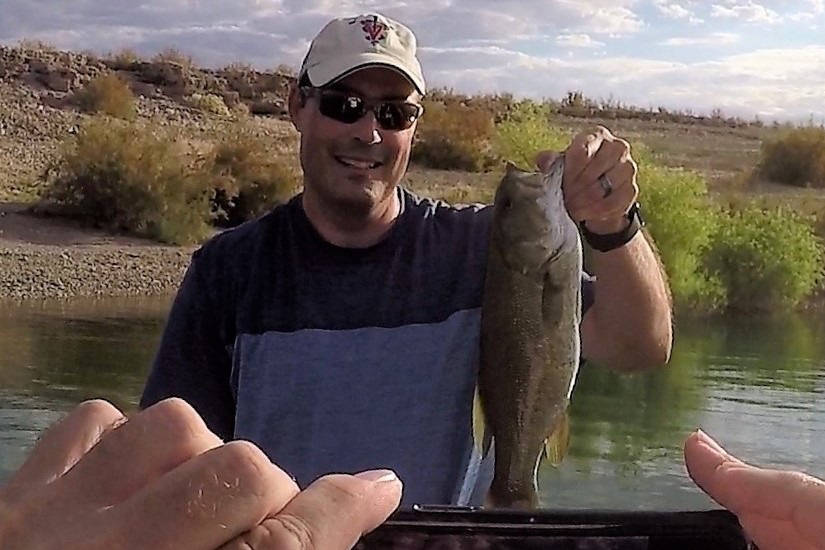Fishermen must adapt to summer temperatures in Las Vegas
Have you wondered what happens to bass when summer temperatures are turned up to just plain hot?
Me, too.
And like many of you, I have spent more than a few frustrating summer days researching the subject with a fishing rod in hand, reading about summer bass behavior and watching pro anglers teaching about the subject in online videos.
The common answer to the question is that the fish go deep when temperatures climb, but what does that really mean?
After all, deep on a small reservoir in one of the southern states where maximum depths might reach 40 feet or so is a far cry from deep at one of our large western reservoirs where the water’s depths easily surpass the 100-foot mark. And that within a short distance of shore.
Such is the case along much of the shoreline at Lake Mead, which was created when deep and steep desert canyons were filled with water after Hoover Dam was finished. The depth of those underwater canyons, combined with the steepness of the associated terrain, limits the percentage of the reservoir where you will find the structure largemouth and smallmouth bass prefer. Knowing that can save an angler who is new to Lake Mead a lot of wasted time.
Water depth and temperatures have played a significant role during my past two fishing forays at Lake Mead. One occurred late in the afternoon and the other early in the morning.
The first of those outings took me to the Boulder Basin late on a Saturday afternoon in June. I paddled my kayak along a familiar shore marked by several small coves separated by short points that reach out toward deeper water. During the next couple of hours, I worked the shallows unsuccessfully with multiple bait options.
Then, with the sun headed toward the horizon, I finally set my pride aside, threw out a deep diving crankbait and started paddling. Not wanting to get hung up, I moved out to water that was 25 to 30 feet deep. Within a few minutes, I reeled in a plump largemouth bass that smacked the crankbait as it passed over the submerged end of a north-running point.
Since it worked once, I tried it again, and it wasn’t long before a scrappy smallmouth took his turn at the lure. It was then I finally remembered the whole high temperature-deep water connection. The fish had moved into the deeper water during the hottest part of the day and simply had not moved back into shallower depths for the evening feed.
The second outing took place Saturday morning in the Overton Arm of Lake Mead. Jed Topham of Henderson and I put in at Echo Bay and motored to the Gold Butte side. It was there that the morning shade would last the longest, and we took advantage of it.
We picked a cove that had a long point on the north side and stayed wide at the back. Then the shoreline swung around on the south to where a short point gave way to long patch of partially submerged brush.
Jed started working the north shoreline with a Ned rig as I began searching with a chartreuse and white spinnerbait with willow leaf blades. It wasn’t long before that spinnerbait fooled a largemouth bass that might tip the scale at close to 3 pounds.
A few minutes later, Jed and I hooked up on smallmouth bass at the same time. This time I was using a dropshot with a Keitech swimbait and Jed continued throwing that Ned rig with a soft red and black stick bait. Between the morning shade and some good cloud cover, temperatures remained tolerable and the fishing action stayed good.
Things changed, however, when we lost the cloud cover and temperatures quickly climbed beyond the hot mark to roasting. The bite shut down almost immediately, and despite our best efforts we couldn’t fool another fish because they were gone.
When we did see them on the fish finder, it was clear the fish had moved into deeper water when the temperature began to climb. There they settled in along submerged structure in water about 25 to 30 feet deep to wait for the sun and temperatures to drop. With the temperature passing 112 degrees, it wasn’t long before we looked for somewhere to hide from the sun ourselves.
Freelance writer Doug Nielsen is a conservation educator for the Nevada Department of Wildlife. His “In the Outdoors” column, published Thursday in the Las Vegas Review-Journal, is not affiliated with or endorsed by the NDOW. Any opinions are his own. Find him on Facebook at @dougwritesoutdoors. He can be reached at intheoutdoorslv@gmail.com.




























